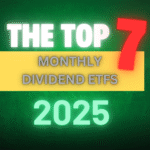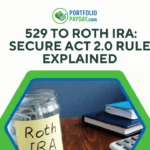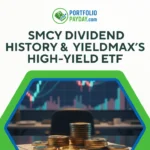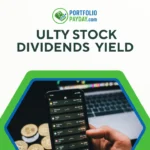Disclaimer: The following is for informational purposes only and not financial advice. Always do your own due diligence.
Are you new to dividend investing and feeling overwhelmed?
Trust me — you’re not alone. When I first started my journey, I had no idea where to begin. The world of dividend stocks, ETFs, high yields, and payout ratios felt like a foreign language. But here’s the truth: dividend investing isn’t nearly as complicated as it seems.
In fact, if you follow a few core principles, 7 of which I am going to discuss today, you can build a dividend portfolio that grows steadily, pays you passive income, and sets you on the path to financial freedom.
In this post, I’m going to walk you through 7 dividend investing rules that every new investor should follow. I’ll share my own personal insight and lessons I’ve learned from my own journey, common mistakes to avoid, and how to start investing with confidence.
Let’s dive right in.
Rule #1: Avoid Chasing High Yields
If you’re anything like me, then you’ve probably scrolled through countless lists of dividend stocks, seeing yields of 0.5%, 1%, 2%, etc. You think to yourself, how am I ever going to retire on such a low yield? But then you probably see the social media influences talking about a 30% or 40% yield. At first glance, it looks like the perfect money-making machine. Who wouldn’t want a double-digit return just for holding a stock?
Here’s the problem: super high yields are often a sign of trouble. A stock with an unsustainably high dividend might be in financial distress. Maybe its stock price is crashing, or the company’s payout ratio is through the roof. Or, there’s massive NAV erosion. These are red flags that the dividend could be cut at any moment.
Instead of chasing the highest yield you can find, focus on quality companies and ETFs with sustainable payouts. For example, I personally enjoy adding NEOS ETFs like QQQI and SPYI to my portfolio. They offer attractive yields but are built on a foundation of stability.
So before you buy anything, always, always, always do your research:
-
Check the company’s payout ratio (ideally below 60% for most industries).
-
Review its earnings growth and dividend history.
-
Ask yourself: Is this yield realistic, or is it a trap?
Rule #2: Be Patient — Dividend Investing is a Marathon
Dividend investing isn’t about getting rich overnight. It’s about building a long-term income machine that rewards you year after year.
Think of it like planting a tree. In the beginning, your portfolio might grow slowly. In fact, you might feel like you’re wasting your time because you’re barely making any income at all from dividends. But as time passes, your dividends start to snowball. Reinvested dividends buy more shares, which pay even more dividends, creating a powerful compounding effect.
The key to dividend investing is to have patience.
When I first started, I was frustrated that my dividends felt small. But fast-forward a few years, and I started to see real growth — not just in my income but in my confidence as an investor.
Remember, the stock market rewards those who think in decades, not weeks. Stay the course, and your future self will thank you.
Rule #3: Understand Your Taxes
Did you know that not all dividends are taxed equally?
There are two types of dividends you’ll encounter:
-
Qualified Dividends: These come from U.S. companies like Coca-Cola. They are taxed at the lower long-term capital gains rates (0%, 15%, or 20%) depending on your income.
-
Non-Qualified Dividends: These are often paid by REITs ( think Realty Income or Vici, BDCs (like ARCC or CSWC), or certain ETFs and are taxed as ordinary income — potentially up to 37%!
If you’re not careful, taxes can eat into your returns. That’s why many investors use tax-advantaged accounts like Roth IRAs, Traditional IRAs, or 401(k)s to shelter their dividends.
Tip: Hold high-yield REITs or BDCs in tax-sheltered accounts while keeping qualified dividend payers in a regular brokerage account. This small strategy can help you keep more of your hard-earned money.
Rule #4: Stay Strong Through Market Volatility
The market goes up. The market goes down. Sometimes for no reason at all.
As a dividend investor, you have one major advantage over traders: you get paid to wait.
If a company’s fundamentals are still strong and the dividend is safe, don’t panic when the stock price drops. Panic selling is one of the fastest ways to destroy wealth.
Instead, use downturns as buying opportunities. I like to remind myself of the classic Warren Buffett quote:
“Be fearful when others are greedy, and greedy when others are fearful.”
For example, during market corrections, I often add to ETFs like SCHD, VOO, or SPYI because I know these long-term winners will bounce back.
Rule #5: Always Reinvest Your Dividends (DRIP)
Reinvesting your dividends, also known as DRIP (Dividend Reinvestment Plan), is literally one of the easiest ways to supercharge your portfolio.
Why? Because when you reinvest dividends, you buy more shares, which then pay you even more dividends. This is compounding in its purest form.
Here’s a real example:
If you invested $100 per week into QQQI (NEOS High Income ETF) for 20 years and reinvested your dividends, you could end up with $542,000 and nearly $81,000 in annual dividend income.
Without reinvesting? Your portfolio would only grow to about $129,000 which is a massive, massive difference.
Rule #6: Diversify Your Portfolio
Never put all your eggs in one basket.
Dividend investors who rely too heavily on a single stock or sector can get burned when that sector underperforms. Instead, spread your investments across multiple industries, such as tech, energy, utilities, REITs, financials, healthcare, and more.
For new investors, ETFs are a great way to achieve instant diversification. My favorites include:
-
VOO (Vanguard S&P 500 ETF)
-
SPYI (NEOS S&P 500 High Income ETF)
-
QQQM (Invesco Nasdaq 100 ETF)
These ETFs give you broad market exposure and a steady stream of dividends.
Rule #7: Always Consider Risk
Dividend investing isn’t risk-free. Companies can cut or eliminate dividends if they’re struggling financially.
Here’s what I always check before buying a stock:
-
Dividend Yield: Too high often means unsustainable.
-
Payout Ratio: Under 60% for most companies is considered safe.
-
Debt-to-Equity Ratio: Companies drowning in debt are at higher risk.
-
Sector Exposure: Overweighting one sector can leave you vulnerable.
Pro tip: Look for companies with a strong history of paying, and raising, their dividends. Dividend Aristocrats (companies with 25+ consecutive years of dividend growth) are a great place to start.
Why Dividend Investing Works
Dividend investing isn’t just about collecting passive income. It’s about building long-term wealth. Companies that pay consistent dividends tend to be profitable, stable, and shareholder-friendly.
When combined with a disciplined approach, like the 7 rules above, you can create a portfolio that:
-
Pays you while you sleep.
-
Grows your wealth over time.
-
Provides financial security in retirement.
How to Get Started with Dividend Investing
If you’re just starting out, here’s a simple 3-step plan:
-
Start Small: Even $50–100 per week is enough to begin.
-
Pick Reliable ETFs or Dividend Growth Stocks: SCHD, VOO, and SPYI are excellent beginner-friendly options.
-
Reinvest Your Dividends: Turn on DRIP and let compounding do the heavy lifting.
Final Thoughts
Follow these 7 dividend investing rules, and you’ll be well on your way to building a portfolio designed for steady, long-term success.
If you haven’t started investing yet, what’s holding you back? Drop a comment and let me know.





![Is SCHD Dead Weight — Or the Ultimate Dividend Machine? [2025 Guide]](https://portfoliopayday.com/wp-content/uploads/2025/08/SCHD-Thumbnail-150x150.png)









[…] If you’re new to dividend investing, check out the video below, or read this post here about the 7 Rules of Dividend Investing for New Investors. […]
[…] Dividend investing is a time-tested strategy used by everyone from beginner investors to multimillionaires. Think Warren Buffet and his wildly famous investment in Coca Cola. In 2024, he collected $776 million dollars in dividend income from his investment, and that’s just passive income. […]
[…] Dividend investing is not a quick path to wealth, but it is one of the most reliable ways to grow retirement income portfolios over time. The sooner you start, the stronger your compounding effect will be. […]